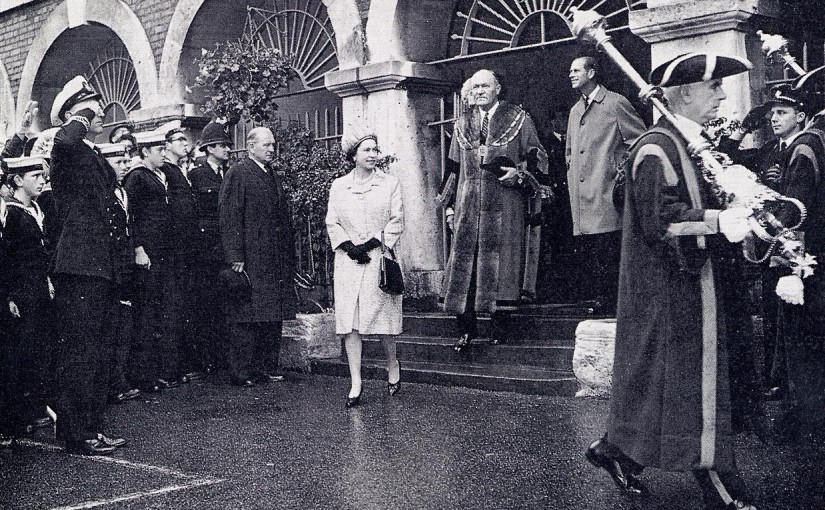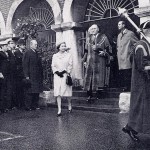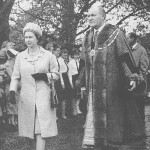There have been comparatively few royal visitors to Rye when the importance of the town in the middle ages is taken into account.
What might be termed flying visits were made by Edward III and Henry VII. On 9th May, 1360 Edward landed at Rye on his way to London, having signed the Treaty of Bretigny on the previous day. Little is known about the brief visit of Henry in August, 1488, except that the corporation expended the princely sum of £2/18/11 on his entertainment.
Undoubtedly, Rye’s most distinguished royal visitor was Elizabeth I that “superb and matchless flower” in the summer of 1573. Tradition informs us that she drank of the water at Queenswell and that both she and her train had an alfresco meal there, proceeding thereafter through the Postern Gate, where she was met by the Mayor and Jurats, who escorted her into the town. She probably arrived on 11th August, 1573 but very little is known about the details of her stay. She is reputed to have dubbed the town “Rye Royal” in consequence of “the noble Entertainment she had, accompanied with the Testimonies of Lore and Loyalty, Duty and REVERENCE she received from the people”. Whether she did this before or after she received a purse of one hundred golden ANGLES from the Mayor is unknown.
What is definitely known is that she visited Winchelsea dubbing it “Little London”, knighted Thomas Shirley of Wiston and that the duration of her visit was three days.
An exceptionally severe storm provided an unintentional royal visit in January, 1726, George I coming ashore at Camber. On hearing the news, James Lamb, the Mayor, rode out of the town with some of his jurats, escorted the King into the town and offered him the hospitality of his home. As Mrs. Lamb had just given birth to a son, the king obligingly stood godfather to the boy, presenting him with a handsome silvered bowl. It has often been said that, as the king could only speak German and Lamb only English, conversation must have proved exceedingly difficult. Perhaps, an answer is to be found in the fact that the King was a fluent speaker of Latin and that Lamb, like Walpole, conversed in that language. On his departure, His Majesty, escorted by the Mayor and Jurats, went through Longer Street (now called High Street) where the town’s trained band stood under arms and lined the street: the bells rang in the church tower and the great guns and small arms roared out their loyal farewell.
Just over thirty years later in March 1756, James Lamb again acted as host to royalty in the person of the Duke of Cumberland third son of George II who was inspecting the coastal defences in view of the imminent war with France. At the Landgate he was welcomed by the Mayor, James Lamb, Jnr. and the whole of the corporation and humbly offered the keys of the town. The Duke was then conducted to the Town Hall, where he received the freedom of Rye, being, hereafter, entertained by the Mayor’s father at Lamb House. Early the next morning he departed.
According to Holloway, Charles II came to Rye in 1673 and George II in 1736, but there is no evidence to support his contentions.
Since 1756 official royal visitors have been few indeed. H.R.H. Princess Louise, Duchess of Argyll attended the opening of Rye, Winchelsea and District Memorial Hospital on 13th November, 1921. In March, 1935, Queen Mary visited Great Dixter, Iden and Rye, where she went to the parish church, Town Hall and an antique shop.
There were apparently several unofficial visits by George V. during the 1930’s. There are stories of him being seen around the town and of staying at Lady Maud Warrender’s mansion in Leasam Lane. Famous Rye fisherman Harry Crampton had a story of a fishing trip the King made with him in Rye Bay and how he landed George V. on the beach at Rye Harbour from his sail powered ‘steam trawler’ (apparently the steam engine was not used to propel the vessel only as power to winch in the nets).
A short visit was made by the Duke of Gloucester in 1938. In the early part of World War Two a royal visit was made by King George VI, the noble father of the present Queen.
It was twenty-six years after her father’s visit that Her Majesty, Queen Elizabeth II accompanied by H.R.H. Prince Phillip paid an official visit to the town on a tour of the South-East.
In spite of Rye’s long history, her importance in the defence of the realm for many centuries, the monarchs, who have entrusted her with many tasks and granted her so many privileges and immunities, have rarely entered the walls. This, however, has not caused Ryers to doubt the wisdom of the monarchal principle and, consequently, although Her Majesty’s visit was brief, and her role in the Constitution entirely different from that of Elizabeth I, they gave her the most loyal and hearty welcome.
At 11.37 am. on Friday 28 October, the royal party arrived at Cadborough Farm. Not since the far off days when the Ancient Town of Rye was one of England’s most important navel ports had there been an occasion like this. At Cadborough Farm, the home of the Mayor and Mayoress of Rye, Alderman and Mrs. W.J. Hacking, the Queen was received by the Lord Lieutenant of Sussex who presented the Mayor and Mayoress and the Mayor’s Daughter-in-Law, Mrs. W.R. Hacking.
Her Majesty was then shown the racehorse Augustine which had formerly belonged to her. A gelding by Auriole (a former Derby winner) out of Young Entry and a full brother to Goodwood Cup winner Augustine, was given to Queen Elizabeth the Queen Mother by Her Majesty and was trained by Jack O’Donohue at Reigate. When Miss Julie Barlow, who worked at the Reigate Stables, left in 1964 to marry the Mayor’s son, Mr. W. R. Hacking, the Queen Mother gave permission for Miss Barlow to take the horse with her. Rider and Horse were very popular with Rye Point-to-Point Race followers winning many Ladies’ Races.
The Mayor proceeded to the Town Hall, where he was robed in his mayoral gown to receive Rye’s Royal visitors.
HRH Queen Elizebeth 11 with Rye Mayor John Hacking in Rye Churchyard November 1966
The Queen’s car made its way through flag waving lines of people by way of Udimore Road where the Badger Gate building was pointed out to The Queen and Prince Phillip, they waved and smiled to Rye’s Senior Citizens as they passed. In Ferry Road they slowed and waved to the Primary School children lining the route.
Rye grammar School pupils waved and cheered as the car flying the Royal Standard drove through Cinque Ports Street.
At the Landgate, the historic gateway to Rye, a great crowd who had waited patiently in the rain were rewarded with a glimpse of the Royal couple as the car passed through the well loved landmark. On Hilder’s Cliff children from the County Secondary School and the Collegiate School lined the Royal route. Through the High Street and into East Street the flag waving welcome was continued, then onto Market Street and the Town Hall.
As Her Majesty alighted from the Royal Car the cheering crowd could see she was dressed in a pink tweed coat flecked with white, over a pink dress. She wore a close fitting hat in matching pink, with black accessories. Prince Phillip waved his hat to the crowd as the Royal Party walked into the Town Hall. The Mayor presented the Town Clerk, Mr. J. D. Smith and Mrs. Smith before escorting the visitors up the stairs to the council chamber.
The moment The Queen entered the Town Hall the Royal Standard was hoisted on the Flag Staff.
Two faces were missing from the Aldermen, Councillors and officials who were presented to Her Majesty on that historic day. Councillor Macer was in hospital recovering from an operation and Alderman Chandler tragically died two days before, he had been Mayor of Rye and Baron of the Cinque Ports in 1953 year and was present in Westminster Abbey for the Coronation.
After the presentations The Queen and Prince Phillip signed the visitors book and photographs of themselves.
The shower had passed by the time the Royal Party emerged from the Town hall on their way to The Church.
Macebearers, Bert Polley and Fred Parris led the procession followed by The Queen accompanied by the Mayor and Prince Phillip with the Mayoress followed by Aldermen and Councillors. Officers of the Sea Cadets, The Air Training Corps and the St. John Ambulance saluted as the Sovereign walked past. As Her Majesty left the building the Royal Standard was struck and replaced with the Union Jack.
At the North Door of St. Mary’s Church the Mayor presented the Vicar, Reverend J. E. R. Williams and Mrs. Williams and wardens, Mr. F. E. Orford (Vicars Warden) and Mr. E. J. Hickmott (peoples warden).
At the South Door, the boys and girls of the Scouting movements and the Red Cross lined the pathway and waited expectantly for the Queen and Prince Phillip to appear. They had not long to wait, the procession passed through the Church and out into the picturesque churchyard. Prince Phillip found the time to speak with several children as the procession made its way to the Memorial.
At the War Memorial, John Button, a fisherman who had lived in Rye all his life, waited to greet Her Majesty with a gift of Rye Bay Bloaters. The Prince asked John “What should be eaten with Bloaters?”, “Bread and butter” replied John “anything else might spoil the flavour.” The Queen was interested in a fishing boat making its way up the Rother. “Is that a Rye trawler?” she asked John, he proudly informed her that it was.
The Church Clock had struck twelve and the time had come for departure but the Royal pair seemed to be in no hurry to leave the Ancient Town. When they finally moved to the Royal Car it seemed as if they went with a reluctant step.
The ride through Church Square, West Street and down Mermaid Street over Rye’s famous cobbles must have been quite an experience for The Queen and Prince Phillip, they laughed as their driver had to reverse to get round the corner from Church Square into West Street and they seemed to be really enjoying the bumpy ride down flag bedecked Mermaid Street.
It was a brief visit but it seems they enjoyed it. “Rye’s Own” had a very nice letter from The Queen’s Secretary thanking us for the copy of the souvenir magazine we sent to the Palace and saying how much they had enjoyed their time in Rye.
In 1980 Queen Elizabeth The Queen Mother, in her capacity as Lord Warden of the Cinque Ports, came to Rye during one rather wet July afternoon. The visit was part of her 80th. birthday celebrations. Her Royal Highness The Queen Mother followed her daughter’s footsteps to the Town Hall where the Mayor of Rye Councillor Jo’ Kikham and members of the Rye Town Council were presented. She signed the visitors book and proceeded to St. Mary’s to meet Canon John Williams and hear a rendition of ‘Sommer is y-comen in’ by the Ryesingers. Unfortunately it was far from a nice summer afternoon and an umbrella was the order of the day for the gracious lady as she made her way to the Gungarden where she unveiled a plaque commemorating the two cannon that had been made and sited there to commemorate her eightieth Birthday. Jo’ Kirkham presented the Queen Mother with a special gift, a plate made at Rye Pottery by Pam Goddard and decorated by June Woolley. Both Pam and June were presented to Her Majesty.
The last visit by a Royal to Rye was in 198? when H.R.H. Princess Margaret opened the Rye Memorial Care Centre.
Now we are left to speculate when the next visit from a Royal personage might be. Despite growing dissatisfaction with the monarchy in some quarters there is no doubt that Rye will always afford them a warm greeting.
From “Rye’s Own” March 2004
All articles, photographs, films and drawings on this web site are World Copyright Protected. No reproduction for publication without prior arrangement. (Hard Copy Back Numbers Still Available) © World Copyright 2017.


